Bulletin – June 2018 Global Economy Trends in China's Capital Account
- Download 767KB
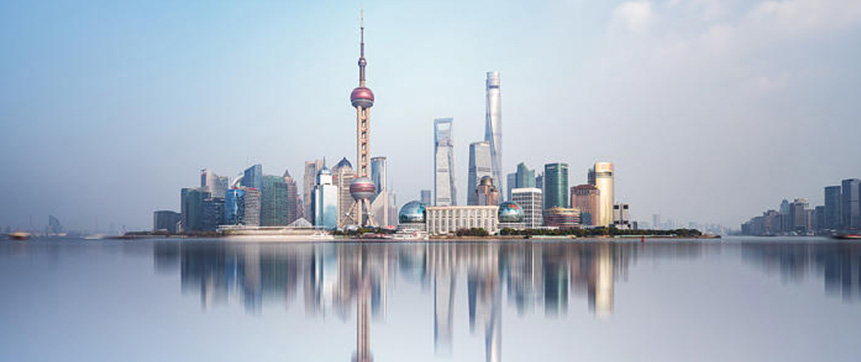
Abstract
Chinese policymakers' approach to liberalising capital flows has been gradual and controlled over time, as the authorities have sought to mitigate volatility in the Chinese renminbi (RMB) and private capital flows. Direct investment flows out of China have grown, become more diversified and have increasingly been accounted for by private investors. Banking-related flows have proved more volatile and are correlated with expectations for the RMB.
Introduction
A key link between China's financial system and those of other countries is the international flow of capital. The Chinese authorities have stated a long-term intention to allow capital to flow more liberally across China's borders. This goal is associated with a number of benefits that could hasten China's ongoing economic transition. In particular, it could help Chinese market participants diversify risk, finance investment more efficiently and benefit from the liquidity and governance advantages of deeper markets.
However, the authorities have long recognised that the process of moving towards freer capital flows is not without risk.[1] Historical experience has shown that such reforms can be accompanied by sudden reversals in capital flows, with large movements in the exchange rate and financial instability weighing on economic growth and inflation. The experiences of many emerging markets in liberalising capital flows has prompted the International Monetary Fund (IMF) to note that sequencing capital account liberalisation with reforms that strengthen domestic institutions and improve regulatory frameworks can help China withstand the adjustment to free capital flows (IMF 2012). The fundamental trade-off between freer capital flows and stability in China's currency, the renminbi (RMB), has also shaped policy.[2]
As a result, capital account liberalisation in China has been carefully sequenced, gradual and heavily managed by the authorities. In particular, several broad themes have characterised the Chinese approach to capital account liberalisation over a long period of time:
- The authorities have shown a willingness and ability to alter the pace of liberalisation when the trade-offs mentioned above have been binding and/or when the RMB has been volatile. In other words, the pace and sequencing of reforms has not been steady; sometimes the pace has slowed, such as in the late 1990s Asian financial crisis or the 2008 global financial crisis when capital outflow and financial stability concerns were heightened.
- Policymakers have favoured liberalising capital inflows more than outflows to facilitate domestic economic development.
- Longer-term and more stable flows like foreign direct investment (FDI) have been liberalised more than more volatile portfolio flows to mitigate the risk of capital flight.[3]
- Official and institutional investors have traditionally been granted greater freedom in their ability to undertake capital account transactions, compared to other types of investors such as corporations or financial institutions. For instance, Chinese state-owned enterprises (SOEs) were historically allowed to invest abroad more than private companies, allowing policymakers some control over the flow of capital out of China.
This article examines how the liberalisation of China's capital flows has evolved over the past few years in the context of these historical features of the Chinese approach.[4] Continued liberalisation could have implications for other economies. Accordingly, the article also investigates cross-border capital flows between China and Australia in particular, and discusses the implications for Australia.
China's Activist and Gradual Approach to Capital Account Liberalisation
Developments in China's capital account and the RMB in the past five or so years represent a continuation of the ‘start–stop’ approach to capital account liberalisation.
Pre-2014: steady, gradual liberalisation
Over the decade or so before to 2014, liberalisation of the capital account and exchange rate regime progressed steadily. Policymakers gradually moved towards greater freedom in the movement of capital and flexibility in the exchange rate. The authorities removed restrictions on certain types of capital flows. Between 2010 and 2014 there were further reforms, as the authorities allowed a range of Chinese entities to invest abroad (see Appendix A). The use of the RMB for international transactions was also promoted, creating channels through which private capital would be able to flow out of China (Lowe 2017).
Broader market conditions during this period were conducive to such reform. China had experienced net inflows of private capital (Graph 1). These were attracted by high expected returns from investment (in line with the large positive growth differential between China and the rest of the world) and a view that the RMB was undervalued and so would appreciate over time (Graph 2). Against this backdrop and given that many capital flow restrictions were still in place, the risk of destabilising capital flight was perceived to be low. However, the authorities moderated the degree of upward pressure on the RMB, motivated in part by concerns about the potential negative impact of a sharp appreciation on the external sector, by accumulating substantial foreign exchange reserves.[5] The ongoing costs of accumulating these reserves are also likely to have provided some impetus for reform.[6]
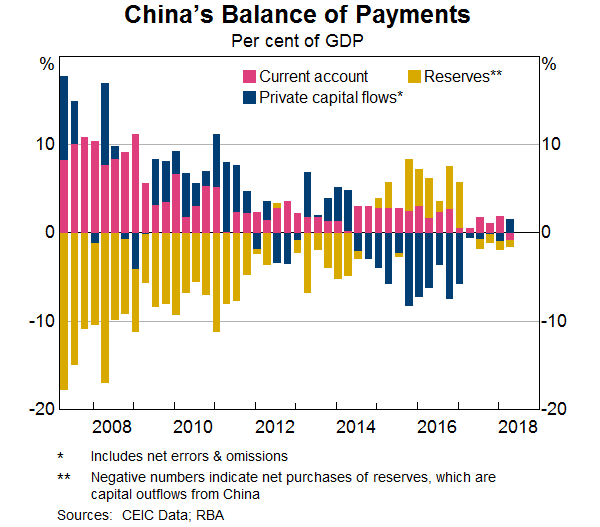
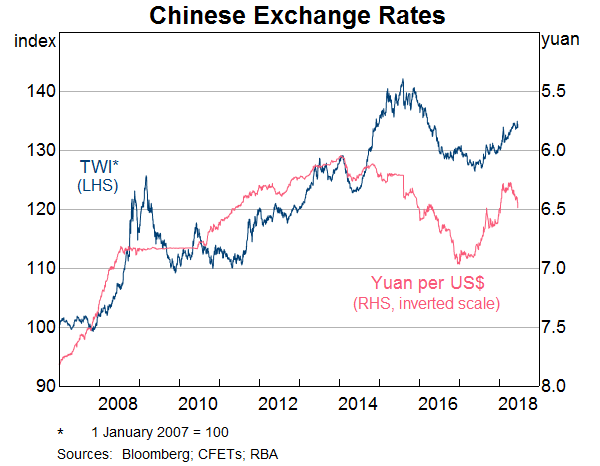
Capital outflows and RMB volatility from 2014 to 2016 prompted a slowing in capital account reform
From late 2014, there was a notable change in market conditions; private capital flows began to reverse, flowing out in net terms. China's growth outlook had weakened, prompting expectations for an easing of monetary policy and a depreciation of the RMB (both of which meant a decline in the returns that could be earned in China relative to investing capital elsewhere). Outflows accelerated in August 2015 following the unexpected decision by the People's Bank of China (PBC) to allow the currency to become more market determined. This triggered a sharp decline in the value of the RMB and growing expectations for further depreciation, seen for instance in the sharp decline in the ‘RMB offshore premium’ (the difference between the freely traded offshore RMB and the more restricted onshore RMB) (Graph 3). Almost US$1 trillion in private capital flowed out of China between mid 2014 and early 2017, most of which was accounted for by banking-related flows such as Chinese firms repaying foreign debt (see below).
The authorities responded to capital outflows by pausing the process of capital account liberalisation. New controls on capital outflows were implemented and existing controls were enforced more stringently, while efforts to encourage capital inflows continued (Appendix A). The authorities also increased their control over the RMB in 2017, making it less market driven at the margin. By this time, the PBC had sold around US$800 billion in foreign exchange reserves since mid 2014.
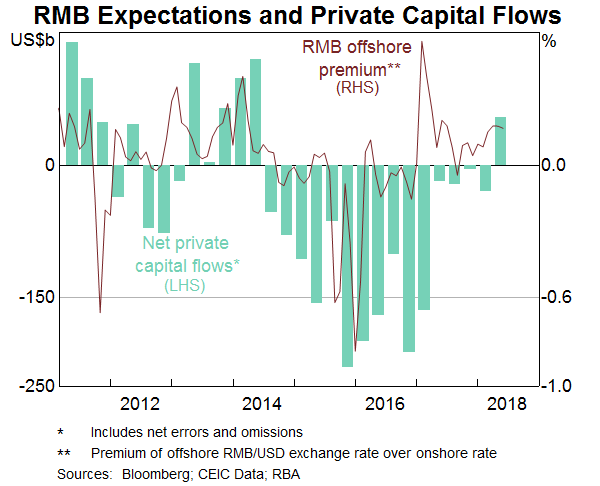
These actions were successful in stemming depreciation expectations and limiting capital outflows. The pace of private capital outflow slowed over 2017 and the RMB appreciated against both the US dollar as well as a broader basket of currencies. Depreciation expectations for the RMB moderated alongside expectations that capital controls would continue to prevent large capital outflows. The improved outlook for the Chinese economy, as well as a broad-based weakening of the US dollar in the second half of 2017, also supported the currency. The PBC's foreign exchange reserves stabilised over 2017 as the PBC was no longer required to support the RMB by intervening in currency markets.
As conditions have stabilised, the authorities have marginally relaxed a number of controls on the capital account. In 2018, Chinese policymakers have taken tentative steps in again easing restrictions on capital flows and allowing the RMB to become more market driven. Some measures that had been used to control outflows in 2015 and 2016 have been unwound a little, and steps have been taken to open certain parts of China's economy to greater foreign investment.[7]
FDI – More Balanced, Diverse and Privately Led
Alongside increased capital flow volatility in recent years, there have been some underlying changes in several key features of China's capital flows. These are clearest when dividing capital inflows and outflows according to their type – FDI, banking-related, portfolio and ‘net errors & omissions’ (Graph 4).[8]
Historically, China's capital flows have been dominated by FDI. Cross-border investments are considered to be FDI if an investor gains control or a significant degree of influence on the management of a foreign company. As noted earlier, these generally more stable capital flows have been subject to fewer restrictions than other types of capital flows, particularly for inflows.
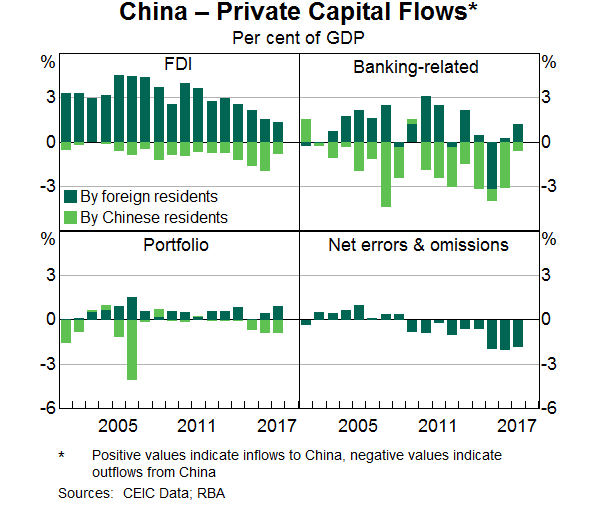
| Q1 2009 – Q1 2014 | Q2 2014 – Q4 2016 | Q1 2017 – Q4 2017 | ||||
|---|---|---|---|---|---|---|
| Total | Quarterly average | Total | Quarterly average | Total | Quarterly average | |
| Net private capital flows | 927(a) | 44 | −1,525 | −127 | −73 | −18 |
| FDI | 941 | 45 | 124 | 10 | 66 | 17 |
| Banking-related | −9 | 0 | −1,034 | −86 | 74 | 19 |
| Portfolio and derivatives | 194 | 9 | −75 | −6 | 8 | 2 |
| Net errors & omissions | −220 | −10 | −540 | −45 | −222 | −55 |
|
(a) Positive inflow indicates a net capital inflow to China; negative number indicates a net outflow Sources: CEIC Data; RBA |
||||||
In recent years, FDI flows have evolved in line with the authorities' broader objectives. Recent developments reflect China's evolving pattern of economic development and increasing integration into global financial markets. In contrast, earlier in the 2000s, policy towards FDI reflected the need for Chinese firms to expand overseas to supply China with natural resources with a view to supporting rapid industrialisation.[9] Specifically, there have been three broad changes in FDI in recent years, which are closely related.
First, net FDI flows have become more balanced, in the sense that inflows to China are no longer orders of magnitude larger than outflows. Inflows were historically larger, especially to China's manufacturing sector, but these have gradually slowed over the past five years. This has been attributed to a rise in labour and land costs in China and increased competition from other Asian economies (Morrison 2015). At the same time, outbound FDI has picked up markedly.
Second, as outflows of FDI have picked up, they have become more privately led. The acceleration in outbound FDI reflected investments by private Chinese companies as the authorities relaxed restrictions on their ability to invest abroad (see Appendix A). This marked a shift from the past, when outbound FDI was undertaken chiefly by large SOEs. The share of FDI undertaken by SOEs has declined from about three-quarters to one-half, although this is still a high level compared with many other economies, reflecting the relative importance of SOEs in China's economy (Graph 5).
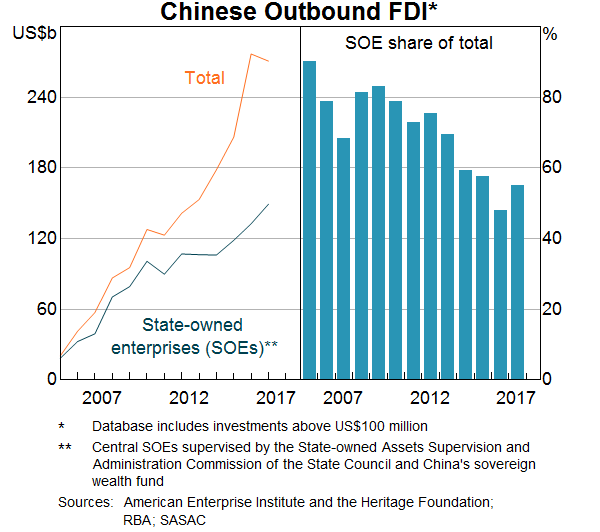
Third, FDI flows out of China have become much more diverse across industries and regions. In the past, state-led FDI was concentrated in resource-rich economies.[10] This reflected efforts by the authorities to secure natural resources by investing in mining, metals and energy-related projects to support rapid investment growth in the Chinese economy. That meant large investments in emerging economies, although advanced resource-rich economies such as Australia were also significant recipients. More recently, private companies have invested in a wider range of industries, including entertainment, tourism and real estate (Graph 6). These investments have been more heavily weighted towards advanced economies, the share of which has increased over time (Graph 7).
In 2017, the authorities began to express concerns that Chinese companies had undertaken ‘irrational’, speculative investments in sectors outside their core areas of business. FDI flows out of China moderated as the authorities tightened surveillance of outbound deals. Domestic financial stability risks were also in focus, given that certain private Chinese companies had financed overseas acquisitions using debt. Investment in sectors such as real estate, entertainment and tourism became formally restricted, while that in sectors tied to China's strategic and technological goals became encouraged (such as mining, agriculture, advanced manufacturing, services and investment related to Belt and Road Initiative projects).
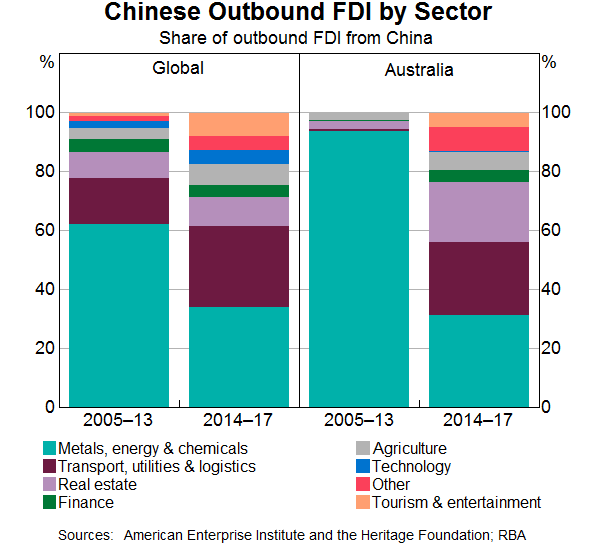
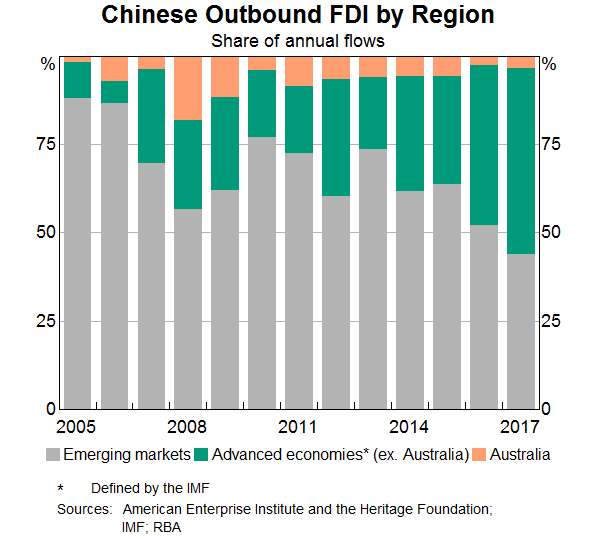
Banking-related Flows – Growing and More Volatile
While historically smaller than FDI, banking-related flows have become an increasingly important component of China's capital account. This has particularly been the case since the authorities took steps to internationalise the RMB from around 2010.[11] These banking-related flows mostly comprise loans, currency & deposits and trade credit & advances.
Banking-related flows have accounted for most of the recent variation in China's private capital flows. Compared with FDI, which can have long lead times and investment horizons, banking-related flows tend to be more responsive to prevailing market conditions. In particular, these flows have been sensitive to changes in expectations for the future path of the RMB. As depreciation expectations intensified between 2014 and 2016, sizeable banking-related outflows occurred. In response to these depreciation expectations, many Chinese entities repaid foreign currency-denominated debt early, extended trade credit & advances to foreign companies at a faster pace, and increased offshore foreign currency deposits.[12],[13] At the same time, foreign entities withdrew RMB deposits from the mainland.
Banking-related flows also drove the turnaround in outflows since 2017 as expectations for RMB depreciation moderated. A number of capital controls that were implemented by the authorities in 2016 and 2017 specifically targeted banking-related flows. For example, tighter restrictions were placed on overseas cash withdrawals and outbound lending. There was also greater scrutiny over foreign currency purchases and cross-border RMB transfers.
There is also evidence to suggest that some banking-related flows are mismeasured and that a large proportion of trade credit & advances are recorded in net errors & omissions (a residual that reconciles the difference between the current account and capital account) (Hatzvi et al 2015).
Portfolio Flows Are Small as They Remain Restricted
Portfolio flows – cross-border investment in debt or equity securities – both to and from China have remained small in aggregate and relative to those in other economies, as they remain tightly controlled (Graph 8). They have played only a very small role in the ebb and flow of private capital flows to and from China in recent years. Portfolio investment can only occur via a handful of closely managed programs, which are subject to limits on the amount and types of investment that can be undertaken. These programs have not always experienced full take-up by market participants, possibly reflecting structural or operational factors such as unfamiliarity with China's legal system or application processes for investment schemes, RMB convertibility or settlement and custody arrangements.
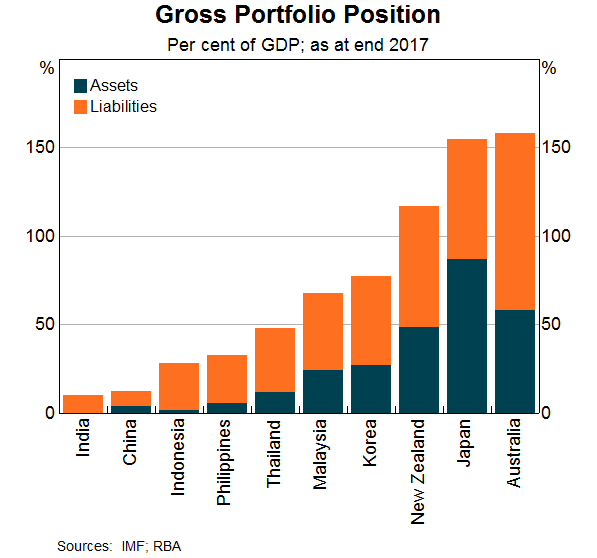
Nevertheless, the Chinese authorities have calibrated the extent to which portfolio-related capital controls bind. Between 2014 and 2016, for example, when RMB depreciation expectations were pronounced, the government stopped issuing new quotas for schemes that allow Chinese residents to purchase overseas debt and equity. In contrast, schemes that allow foreigners to invest in China were relaxed.
China's portfolio flows have considerable scope to be further liberalised. Regulations governing these flows remain tight and the size of these flows in China's capital account is much smaller relative to other economies. If the authorities eased restrictions on portfolio flows, the amount of capital that could enter China and leave China could be large. For instance, Bayoumi and Ohnsorg (2013) estimated that gross portfolio outflows from China could be as high as 15–25 per cent of Chinese GDP over five years in the event of the liberalisation of China's capital account. He et al (2012) found similar estimates. Such large flows would also imply closer links between Chinese and global financial markets.
Implications of Developments in China's Capital Account for Australia
Over most of Australia's history, Australia's high level of investment relative to saving has been accompanied by capital inflows from the rest of the world. Over the past few years, China has become a more important source of these capital inflows. Accordingly, it is worth considering how these developments in China's capital account have affected Australia. Some recent developments have mirrored those in Chinese capital flows more generally, while others have been specific to Australia.
Capital inflows from China have grown but remain relatively small
A useful starting point is to put China's capital flows to Australia in context. Looking at total inflows from China (that is, across all types of capital flows), the value of such flows has grown but remains relatively small. In the past five years, annual Chinese investment in Australia has been around four times higher than the five years earlier.[14] But these inflows were only around 6 per cent of total inflows over this period. Similarly, the cumulative stock of Chinese investment in Australia is about 10 times larger than it was a decade ago, but still represents only about 3 per cent of the total stock of foreign investment in Australia (Graph 9). If investment from Hong Kong is included, the share is around twice as high, but is still relatively small.[15] Advanced economies such as the United States, the United Kingdom, Europe and Japan continue to account for the majority of foreign investment in Australia. Nevertheless, there have been some important developments as the shape of China's capital flows has evolved more generally.
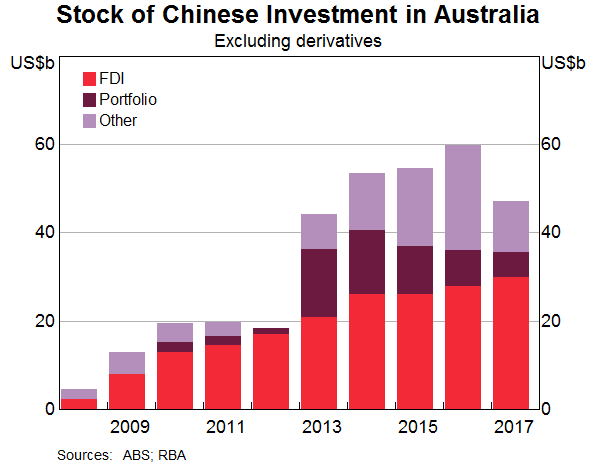
FDI has been stable in size but is changing shape
FDI is the main source of Chinese capital flows to Australia. That partly reflects the outsized role of FDI in China's capital outflows, as noted above. Chinese FDI has risen to account for 8 per cent of total FDI inflows to Australia over the past decade, from close to zero in the preceding period for which data are available (Graph 10). This share is somewhat larger if flows that are intermediated through Hong Kong are included, at around 12 per cent.
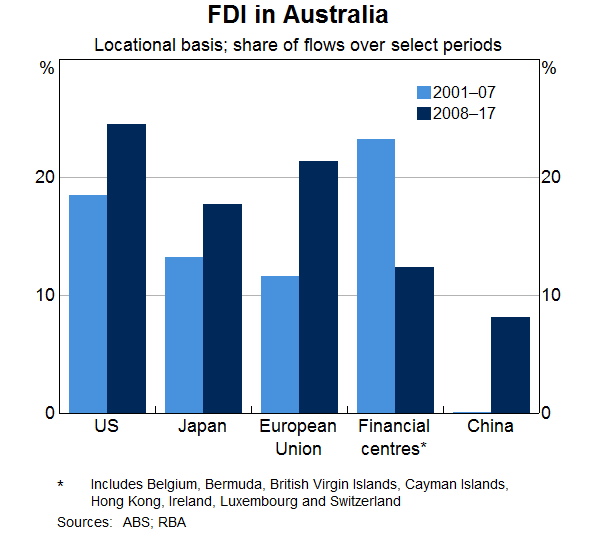
From China's perspective, Australia has been a major destination for outbound FDI (according to the data tracing large investments back to their ultimate investors). This is seen in absolute terms, with Australia having been the second largest recipient of outbound FDI since 2005 after the United States (Graph 11). These flows have also been large given the size of the Australian economy relative to other countries.
Unlike many other economies, Australia did not experience a surge in Chinese FDI over 2014–16. Rather, this period saw a relatively stable level of overall FDI inflows from China to Australia. However, the nature of this investment changed:
- Between the mid 2000s and 2013, large FDI inflows from China funded increases in the productive capacity of Australia's mining sector, of which investment by SOEs accounted for around three-quarters. More recently, inflows of new Chinese FDI into mining have declined, in line with the broader winding-down of mining investment in Australia and sectoral diversification in Chinese FDI.
- Since 2013, there has been some increase in FDI by private investors, which have come to account for a greater share of Chinese FDI in Australia (as they have in global Chinese FDI). These investments have been diversified across sectors, with significant investment in large-scale real estate and infrastructure projects (RBA 2016, Graph 12).[16] Despite these more recent investments, mining still accounts for most of the accumulated stock of Chinese FDI in Australia.
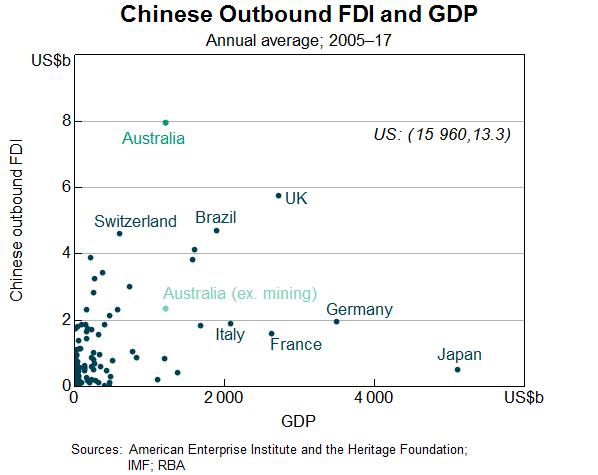
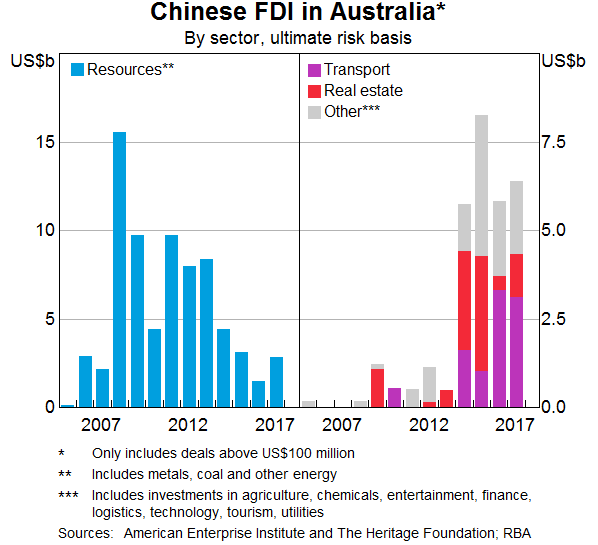
There is some evidence that the recent slowing in the pace of capital account liberalisation by the Chinese authorities has influenced China's capital inflows to Australia. Having increased over the past five or so years, inflows to Australia's real estate sector appear to have moderated since early 2017 after the authorities designated foreign real estate as a ‘restricted’ sector for investment by Chinese residents (Kearns 2017). Nevertheless, Australia appears to be less exposed to a slowing in inflows to other ‘restricted’ sectors relative to other advanced economies. For example, nearly 40 per cent of total Chinese FDI to the United States since 2010 was to entertainment and tourism, compared with only 14 per cent for Australia (Graph 13).
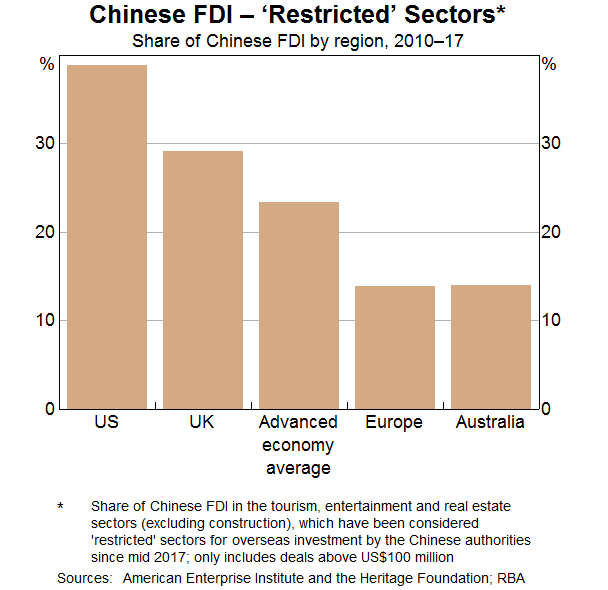
Banking-related flows have been picking up amid increased market share
Banking-related flows have also become an important component of Chinese investment in Australia in recent years, although these have tended to be smaller than FDI. Data limitations make it difficult to determine exactly the nature of these flows. Nevertheless, they appear to broadly line up with data on Australian-based Chinese bank branches' lending in Australia and so are likely to be mainly loans. Chinese banking-related flows may therefore comprise Chinese bank branches intermediating flows between corporate parents in China and their affiliates in Australia. Australian branches of Chinese banks are also often in a good position to assess the creditworthiness of Chinese affiliate borrowers operating in Australia, particularly where they have an existing relationship with the parent group in China (RBA 2016).
Nevertheless, despite this growth in business lending, Chinese banks account for only a small share of outstanding Australian business credit, at just over 3 per cent (below the share of financing provided by European and Japanese banks; Graph 14). Australian businesses overwhelmingly source credit from Australian banks, which account for around 75 per cent of business credit outstanding.
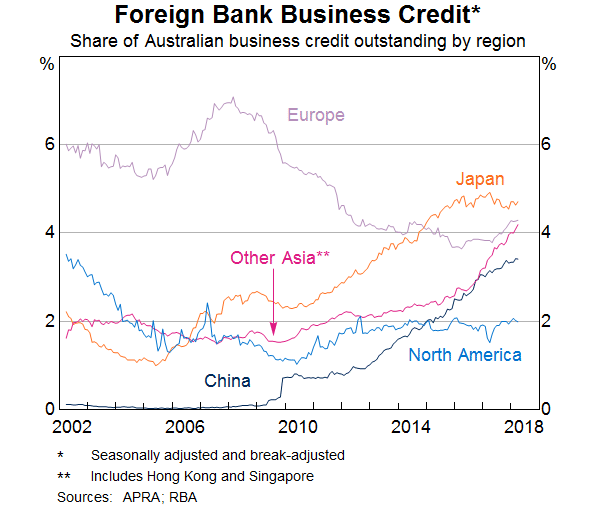
Conclusion
Capital account liberalisation can provide numerous benefits for an economy, but there are also risks associated with the transition to a more open capital account. Chinese policymakers' gradual and controlled approach to liberalising capital flows has reflected their attempt to balance these considerations. There appears to be the most scope for the authorities to further liberalise portfolio flows. Notwithstanding a slowdown in the pace of capital account liberalisation in 2017, FDI flows have historically been subject to fewer restrictions. Renewed efforts to liberalise the capital account are likely to be carefully calibrated and aimed at mitigating volatility in the RMB, especially as China continues to grapple with risks in its domestic financial system (RBA 2018). The pace at which China pushes ahead with further reform will have implications for its own economy and financial system and, inevitably, those of the rest of the world, including Australia.
Appendix A: Capital Account Policy Changes
| Reported date | Measure | Type of capital flows affected |
|---|---|---|
| 2011 | Chinese banks permitted to lend to domestic companies for overseas FDI. | FDI |
| 2012 | RMB trade settlement scheme expanded to cover all trade with China (from pilot schemes previously). | Banking-related |
| Guideline released by the State Council seeking to enhance private companies' ability to invest overseas, especially in key areas such as resources and advanced manufacturing. Approval and management procedures were simplified and fiscal and financial support were enhanced (including loans and tax deductions). | FDI | |
| 2013 | Pilot schemes permitting cross-border RMB lending introduced. | Banking-related |
| “Sweeping” permitted in the Shanghai free-trade zone. | ||
| Outbound investments worth less than US$1 billion no longer require verification and approval unless in a sensitive country or industry; just have to be filed with the government (for investments exceeding US$ 300 million). | FDI | |
| 2016 | Investment limits removed for the Qualified Foreign Institutional Investor and RMB Qualified Foreign Institutional Investor programs, investors given greater asset allocation choice and procedures were simplified. | Portfolio |
|
Sources: Analyst reports, Cockerell and Shoory (2012), Hatzvi et al (2014), NDRC |
||
| Reported date | Measure | Type of capital flows affected |
|---|---|---|
| December 2015 to February 2016 | New quotas for portfolio investment schemes allowing Chinese entities to invest abroad reportedly stopped being issued.(a) | Portfolio |
| January 2016 | Tighter transaction limits on overseas withdrawals using UnionPay cards and purchases of savings-like insurance products abroad. | Banking-related |
| November 2016 | Increased scrutiny over major outbound deals, such as mergers and acquisitions (especially if the deal is in a sector outside the investors' core area of business) and SOEs' real estate transactions. | FDI |
| Increased scrutiny over transfers abroad worth US$5 million or more (previously US$50 million or more needed to be reported), including for multinational companies ‘sweeping’ funds in and out of China. | All outflows | |
| New restrictions on outbound RMB loans extended by domestic companies. | Banking-related | |
| January 2017 | Greater scrutiny on individual foreign currency purchases, which have a US$50,000 annual limit. | Banking-related |
| August 2017 | Formal restrictions on investing in real estate, hotels, entertainment and sports overseas. Other sectors such as mining, agriculture, advanced manufacturing and business services considered to be ‘encouraged’. | FDI |
|
(a) These include the RMB Qualified Domestic Institutional Investor and Qualified Domestic Limited Partner schemes. Launch of the second Qualified Domestic Institutional Investor Program program was also delayed. Sources: Analyst and media reports |
||
Footnotes
The author is from International Department [*]
See Ballantyne et al (2014) for a discussion of Australia's experience in liberalising the capital account. [1]
This trade-off is known as Mundell's trilemma: a country can only pursue two of the following: 1) a fixed exchange rate, 2) free capital mobility and 3) monetary policy independence (Mundell 1963). For example, if a country has a fixed exchange rate and free capital flows but interest rates are lower than those abroad, then private capital outflows would likely occur (putting depreciation pressure on the currency). Policymakers would have to sell foreign currency reserves to maintain a stable currency. Because this cannot be done in perpetuity, eventually policymakers would have to abandon the currency peg, increase interest rates or implement capital controls. [2]
FDI is generally considered to be longer term in nature and driven by economic fundamentals, such as the desire to access new markets, acquire technology and diversify. For this reason, FDI flows tend to be less sensitive to changes in exchange rate expectations than other components of the capital account. [3]
See Hatzvi, Meredith and Nixon (2015) for a discussion of Chinese capital account liberalisation up to 2015. [4]
China maintained persistent current account surpluses, which would otherwise require a net outflow of capital (net Chinese investment abroad). To balance these flows without a larger appreciation of the RMB required an accumulation of reserves. [5]
See Zheng and Yi (2007) for a discussion of some of the costs associated with China's holdings of foreign exchange reserves. [6]
A number of schemes which allow Chinese investors to invest in foreign portfolio assets (subject to quotas) have been reinstated after being suspended in 2015, and the authorities have signalled support for certain types of outbound FDI, such as investment on the Belt and Road Initiative (BRI). The BRI is a Chinese investment and foreign policy initiative seeking to facilitate trade and investment linkages (including the development of railways, ports and special economic zones) along overland and maritime trade routes – in particular, those connecting China with Central Asia, South Asia, the Middle East, Europe and a number of countries in the Asia-Pacific region. [7]
China's capital flows are recorded in China's balance of payments (BOP). The BOP is made of the current account (cross-border flows related to trade) and the capital account, which records transactions involving foreign assets and liabilities. [8]
The authorities began encouraging Chinese companies to invest overseas in the late 1990s with the ‘Go Out’ policy. The policy sought to incentivise certain companies, mostly SOEs, to invest overseas, in some cases offering subsidies, more relaxed regulations and simpler administrative rules. [9]
According to data that track large Chinese investments worldwide (over US$100 million) back to their ultimate Chinese investor, even if they have occurred via another country, such as Hong Kong. [10]
The authorities permitted trade with China to be settled in RMB around 2010 (seeing a pool of RMB develop outside the mainland) and eased restrictions on Chinese enterprises' lending and use of foreign currency deposits. [11]
For example, by prepaying for imports or deferring the receipt of export earnings. [12]
For instance, exporters with foreign currency earnings held them offshore rather than converting them to RMB (Chan 2017). [13]
Excluding derivatives. [14]
Measuring the ultimate source of FDI flows can be difficult. These figures are calculated using data based on the immediate location of the investor. Some Chinese investment in Australia likely flows via other countries (see RBA 2017). [15]
This dataset probably understates Chinese investment in Australian real estate, as the high minimum threshold for investments to be included means they will likely not pick up individual home sales. [16]
References
Ballantyne A, J Hambur, I Roberts and M Wright (2014) ‘Financial Reform in Australia and China’, RBA Research Discussion Paper 2014-10.
Bayoumi T and F Ohnsorge (2013), ‘Do Inflows or Outflows Dominate? Global Implications of Capital Account Liberalization in China’, International Monetary Fund Working Paper No 13/189.
Chan S (2017), ‘Assessing China's Recent Capital Outflows: Policy Challenges and Implications’, China Finance and Economic Review, 5(3).
Cockerell L and M Shoory (2012), ‘Internationalising the Renminbi’, RBA Bulletin, June, pp 77–90.
Hatzvi E, W Nixon and M Wright (2014), ‘The Offshore Renminbi Market and Australia’, RBA Bulletin, December, pp 53–62.
Hatzvi E, J Meredith and W Nixon (2015), ‘Chinese Capital Flows and Capital Account Liberalisation’, RBA Bulletin, December, pp 39–48.
He D, L Cheung, W Zhang and T Wu (2012), ‘How would Capital Account Liberalization Affect China's Capital Flows and the Renminbi Real Exchange Rates?’, China & the World Economy, 20(6), pp 29–54.
IMF (2012), ‘The Liberalization and Management of Capital Flows: An Institutional View’, IMF Policy Papers. Available at <http://www.imf.org/en/Publications/Policy-Papers/Issues/2016/12/31/The-Liberalization-and-Management-of-Capital-Flows-An-Institutional-View-PP4720>
Kearns J (2017), ‘Australian Property – Financial Stability and Foreign Involvement’, Speech at the Aus-China Property Developers, Investors & Financiers Event, Sydney, 20 November.
Lowe P (2017), ‘Renminbi Internationalisation’, Remarks to the RMB Global Cities Dialogue Dinner, Sydney, 27 April.
Morrison W (2015), ‘China's Economic Rise: History, Trends, Challenges, and Implications for the United States’, Congressional Research Service Report RL33534, September.
RBA (Reserve Bank of Australia) (2016), ‘Box B: Chinese Demand for Australian Property’, Financial Stability Review, April, pp 30–32.
Mundell R (1963), ‘Capital Mobility and Stabilization Policy under Fixed and Flexible Exchange Rates’, The Canadian Journal of Economics and Political Science, 29(4), pp 475–485.
RBA (2017), ‘Box B: Chinese Direct Investment in Australia’, Statement on Monetary Policy, November, pp 29–30.
RBA (2018), ‘The Global Financial Environment’, Financial Stability Review, April, pp 3–14.
Sauvant K and V Chen (2014), ‘China's Regulatory Framework for Outward Foreign Direct Investment’, China Economic Journal, 7(1), pp 141–163.
UNCTAD (United Nations Conference on Trade and Development) (2017), ‘World Investment Report 2017: Investment and the Digital Economy’. Available at <http://unctad.org/en/pages/DIAE/World%20Investment%20Report/WIR-Series.aspx>
Zheng Y and J Yi (2007), ‘China's Rapid Accumulation of Foreign Exchange Reserves and Its Policy Implications', China & World Economy, 15(1), pp 14–25.